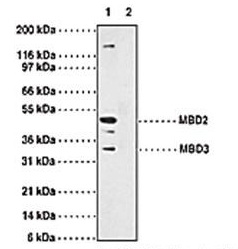MBD2/3 (Clone 106B691) Antibody
Mouse Monoclonal Antibody
- SPECIFICATION
- CITATIONS
- PROTOCOLS
- BACKGROUND

Application
| WB |
|---|---|
| Primary Accession | O95983 |
| Reactivity | Human |
| Host | Mouse |
| Clonality | Monoclonal |
| Isotype | Mouse IgG1κ |
| Clone Names | 106B691 |
| Calculated MW | 32844 Da |
| Gene ID | 53615 |
|---|---|
| Positive Control | HeLa cell nuclear fraction |
| Application & Usage | Western blot analysis (2-4 µg/ml). However, the optimal conditions should be determined individually. |
| Other Names | Methyl-CpG-Binding Domain 2/3 |
| Target/Specificity | MBD2/3 |
| Antibody Form | Liquid |
| Appearance | Colorless liquid |
| Formulation | 50 µg in 100 µl PBS containing 0.2% gelatin and 0.05% sodium azide |
| Handling | The antibody solution should be gently mixed before use. |
| Reconstitution & Storage | -20 °C |
| Background Descriptions | |
| Precautions | MBD2/3 (Clone 106B691) Antibody is for research use only and not for use in diagnostic or therapeutic procedures. |
| Name | MBD3 |
|---|---|
| Function | Acts as a component of the histone deacetylase NuRD complex which participates in the remodeling of chromatin (PubMed:16428440, PubMed:12124384, PubMed:16428440, PubMed:28977666). Acts as transcriptional repressor and plays a role in gene silencing (PubMed:10947852, PubMed:18644863). Does not bind to methylated DNA by itself (PubMed:12124384, PubMed:16428440). Binds to a lesser degree DNA containing unmethylated CpG dinucleotides (PubMed:24307175). Recruits histone deacetylases and DNA methyltransferases. |
| Cellular Location | Nucleus. Chromosome. Note=Nuclear, in discrete foci. Detected on chromatin, at promoter regions of active genes |

Thousands of laboratories across the world have published research that depended on the performance of antibodies from Abcepta to advance their research. Check out links to articles that cite our products in major peer-reviewed journals, organized by research category.
info@abcepta.com, and receive a free "I Love Antibodies" mug.
Provided below are standard protocols that you may find useful for product applications.
Background
DNA methylation, or the addition of methyl groups to cytosine bases in the dinucleotide CpG, is imperative to proper development and regulates gene expression. The methylation pattern involves the enzymatic processes of methylation and demethylation. A demethylase enzyme has been identified which exhibits demethylase activity associated to a methyl-CpG-binding domain (MBD). The enzyme is able to revert methylated cytosine bases to cytosines within the particular dinucleotide sequence mdCpdG by catalyzing the cleaving of the methyl group as methanol. MeCP2 and MBD1 (PCM1) repress transcription by binding specifically to methylated DNA. MBD2 and MBD4 (also known as MED1) co-localize with foci of heavily methylated satellite DNA and mediate the biological functions of the methylation signal. Surprisingly, MBD3 does not bind methylated DNA either in vivo or in vitro. MBD1, MBD2, MBD3, and MBD4 are expressed in somatic tissues, but the expression of MBD1 and MBD2 is reduced or absent in embryonic stem cells, which are known to be deficient in MeCP1 activity. MBD4 has homology to bacterial base excision repair DNA N-glycosylases/lyases. In some microsatellite unstable tumors, MBD4 is mutated at an exonic polynucleotide tract.
If you have used an Abcepta product and would like to share how it has performed, please click on the "Submit Review" button and provide the requested information. Our staff will examine and post your review and contact you if needed.
If you have any additional inquiries please email technical services at tech@abcepta.com.













 Foundational characteristics of cancer include proliferation, angiogenesis, migration, evasion of apoptosis, and cellular immortality. Find key markers for these cellular processes and antibodies to detect them.
Foundational characteristics of cancer include proliferation, angiogenesis, migration, evasion of apoptosis, and cellular immortality. Find key markers for these cellular processes and antibodies to detect them. The SUMOplot™ Analysis Program predicts and scores sumoylation sites in your protein. SUMOylation is a post-translational modification involved in various cellular processes, such as nuclear-cytosolic transport, transcriptional regulation, apoptosis, protein stability, response to stress, and progression through the cell cycle.
The SUMOplot™ Analysis Program predicts and scores sumoylation sites in your protein. SUMOylation is a post-translational modification involved in various cellular processes, such as nuclear-cytosolic transport, transcriptional regulation, apoptosis, protein stability, response to stress, and progression through the cell cycle. The Autophagy Receptor Motif Plotter predicts and scores autophagy receptor binding sites in your protein. Identifying proteins connected to this pathway is critical to understanding the role of autophagy in physiological as well as pathological processes such as development, differentiation, neurodegenerative diseases, stress, infection, and cancer.
The Autophagy Receptor Motif Plotter predicts and scores autophagy receptor binding sites in your protein. Identifying proteins connected to this pathway is critical to understanding the role of autophagy in physiological as well as pathological processes such as development, differentiation, neurodegenerative diseases, stress, infection, and cancer.


